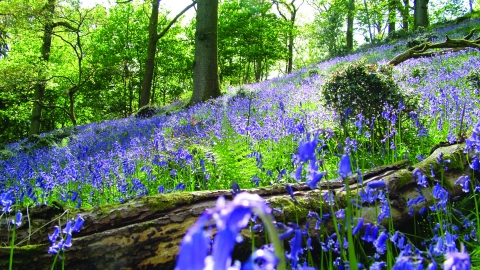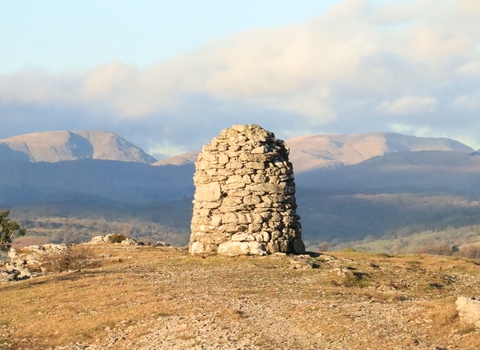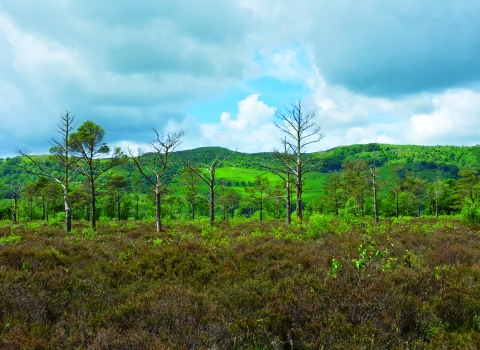
Bluebells in spring at Barkbooth Lot nature reserve © Michelle Waller
Location
OS Map Reference
1:50,000 Sheet no. 97Grid reference: SD 418 909
Getting here
By car:
From Bowness-on-Windermere take the A5074 towards Crosthwaite. South of Winster, just after the Damson Dene Hotel, take a sharp right hand turn and follow this minor road for 1.5km/0.9 miles. Park on the left-hand side of the road at the nature reserve entrance at Sandy Hill.
By bicycle:
The reserve is 8km/5 miles from National Route 70 Walney to Wear (W2W) and National Route 6 Greenwich to Keswick.
By public transport:
Buses run from Kendal to Crosthwaite.
View on What3Words
Know before you go
Dogs
When to visit
Opening times
Open at all timesBest time to visit
April to SeptemberAbout the reserve
Wildlife highlights
- Numerous dragonflies include the downy emerald, emperor and four-spotted chaser. Also look out for the beautiful demoiselle damselfly around Arndale Beck
- In spring - the woodland is alive with the sound of willow warbler, chiffchaff and blackcap.
- Spot scrubland birds such as whitethroat, tree pipit and yellowhammer. See bluebells and other flowers carpeting the woodland floor and hear birds such as chiff chaff and blackcap.
- In summer - watch dragonflies and damselflies darting over the pond and butterflies such as high brown fritillary flitting about.
- In autumn - look out for wax cap fungi in the open fell area.
- In winter - a chance to get good views of woodland birds.
What makes Barkbooth Lot so special?
From the combination of bracken and violets in the grassland forming perfect breeding conditions for the nationally scarce high brown fritillary butterfly – to the tarns that are home to the rare medicinal leech – to the wealth of woodland birds and carpet of bluebells in the spring, Barkbooth Lot is important for wildlife year-round.
A diversity of habitats in a lovely setting
Although relatively small, Barkbooth Lot offers something for everyone! On a clear day from the highest point you can get magnificent views of both the Lakeland fells and Morecambe Bay.
Here, open fell with a mosaic of rough grassland, bracken and scrub, two small tarns and a small meadow contrasts with the mature oak woodland, which together provide an incredibly diverse home for a vast range of species.
A visit here is always rewarding as the range of habitats means there is a huge diversity of species to discover.
Butterflies around the bracken
Walk through the rough grassland areas and look out for the rare high brown fritillary butterfly. The combination of bracken and violets growing here provide ideal breeding conditions for this species, as well as the more widespread dark-green fritillary butterfly.
You may also see other butterflies such as the pearl-bordered and small pearl-bordered fritillaries, orange tip, meadow brown and small heath.
Wildlife around the tarns
The tarns on Barkbooth Lot are great places to spot damselflies and dragonflies. Look out for the downy emerald dragonfly, the emperor, four-spotted chaser and golden banded dragonflies and the common and black darters.
You may also see the common blue, azure and large red damselflies. Have a look for the beautiful demoiselle damselfly flitting over bankside vegetation around Arndale Beck.
Beware near the tarn however as the rare medicinal leech lives here!
Glow worms are also found in the grassland.
Woodland habitat
The woodland provides a wonderful contrast to the open habitats of the rough fell land, with incredible carpets of bluebells in the spring and the dark shade of closed canopy woodland in the summer.
Oak and birch are the most common species along with ash, rowan and sycamore.
On the woodland floor you will find bluebells and bracken, with bilberry dominating in places.
Alder dominates the wetter areas and along the course of Arndale Beck that flows through the southwest corner of the reserve.
The wood is now fenced to deer to try and allow natural regeneration in the many gaps created by windblown trees.
Dead wood, both fallen and standing, is purposefully left to create habitat for many species of invertebrates as well as birds.
Alive with birds
In spring the woodland and scrub areas are alive with the sound of willow warblers, chiff chaff, garden warblers and blackcaps.
You may also hear greater-spotted woodpeckers and green woodpeckers or spot a nuthatch. Look out for hawfinches which are regularly seen on the woodland edge.
Keep an eye open also for buzzard and sparrowhawks.
The combination of rough grassland and scrub provide excellent breeding habitat for many scrubland bird species such as whitethroat, willow warbler, redstart, tree pipit and yellowhammer.
Plantlife
Although Barkbooth Lot does not have any particular rare plant species, the species-rich acid grassland is a rare treat and you may come across northern marsh-orchid, moonwort and adder’s-tongue fern.
Recent history
Barkbooth Lot was given to the Trust in 1975 by Mrs Sheila Caldwell.
Howbarrow Meadow was given in 2004 by Mrs Helen Caldwell.
Part of Low Fell Plantation was purchased in 2007; the remainder is leased from John and Barbara Handley.
Sandy Hill is leased by the Trust from Crosthwaite and Lyth Parish Council. Sandy Hill is a small area of plantation woodland that abuts the road between where the two parts of the reserve meet and there is a small pond at this point. This provides a perfect entrance on to each side of the nature reserve.
Species
- Glow-worm
- Hawfinch
- Grass snake
- Blackcap
- Beautiful demoiselle
- Yellowhammer
- Willow warbler
- Chiffchaff
- Whitethroat
- Bluebell
- Emperor dragonfly
- Four-spotted chaser
- High brown fritillary
- Downy emerald
- Tree pipit
- Pink waxcap
- Dark green fritillary
- Pearl-bordered fritillary
- Small pearl-bordered fritillary
- Orange-tip
- Meadow brown
- Small heath
- Downy emerald
- Black darter
- Common blue damselfly
- Azure damselfly
- Large red damselfly
- Bilberry
- Alder
- Garden warbler
- Great spotted woodpecker
- Green woodpecker
- Nuthatch
- Buzzard
- Sparrowhawk
- Adder's-tongue fern
- English oak
- Silver birch
- Ash
- Rowan
- Sycamore
- Common darter
Contact us
Environmental designation
Take a virtual tour of Barkbooth Lot Nature Reserve
Upcoming events at Barkbooth Lot Nature Reserve
If there are any upcoming events at Barkbooth Lot Nature Reserve we'll show them to you below.
Did you know?
The Freshwater Habitats Trust found 43 plant species and 66 invertebrate species during a survey of the main tarn.

Support our conservation work on this nature reserve,
and protect Cumbria's wildlife & wild places.







